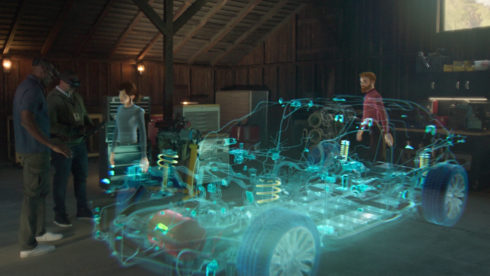
Microsoft is hoping to enable better shared experiences from anywhere with its new mixed reality offering Microsoft Mesh.
The company announced the solution yesterday at Microsoft Ignite with Cirque du Soleil co-founder Guy Laliberté appearing via holoportation, which is a technology that uses 3D capture to “beam a lifelike image of a person into a virtual scene.” During the keynote, attendees were also able to appear as avatars at the conference and watch it together in a shared holographic world.
“This has been the dream for mixed reality, the idea from the very beginning,” said Alex Kipman, Microsoft Technical Fellow. “You can actually feel like you’re in the same place with someone sharing content or you can teleport from different mixed reality devices and be present with people even when you’re not physically together.”
According to Microsoft, this new mixed reality solution is built on Azure and will allow distributed teams to have collaborative meetings, conduct virtual design sessions, assist others, learn together, and host virtual social meetups. Currently, people can join as avatars, but in time they will be able to use holoportation to project a lifelike version of themselves.
RELATED CONTENT:
Microsoft plans for low code with new updates to the Power Platform
Microsoft open sources a low-code programming language for all
Visual Studio 2019 v16.9 and v16.10 Preview 1 and .NET Upgrade Assistant preview
Microsoft Mesh is accessible from any Mesh-enabled app on the HoloLens 2, various VR headsets, mobile phones, tablets, or PCs.
Use cases for Microsoft Mesh include architects and engineers walking through a holographic model of a factor floor, medical students learning about human anatomy, and of course, colleagues meeting up in a virtual space.
Microsoft Mesh is the result of several years of research in areas such as hand and eye tracking, HoloLens development, and creating persistent holograms and AI models that are able to create expressive avatars, the company explained.
Over the next few months, features will be added to the platform such as a full suite of AI tools for avatars, session management, spatial rendering, synchronization across multiple users, and holoportation.
“More and more we are building value in our intelligent cloud, which is Azure,” Kipman said. “In these collaborative experiences, the content is not inside my device or inside my application. The holographic content is in the cloud, and I just need the special lenses that allow me to see it.”
At Ignite, Microsoft shared two apps already built on the Microsoft Mesh platform: a preview of the Microsoft Mesh app for HoloLens and a Mesh-enabled AltspaceVR, which is a VR app where people can meet up in a virtual shared space.
“This is why we’ve been so passionate about mixed reality as the next big medium for collaborative computing,” Kipman said. “It’s magical when two people see the same hologram.”






